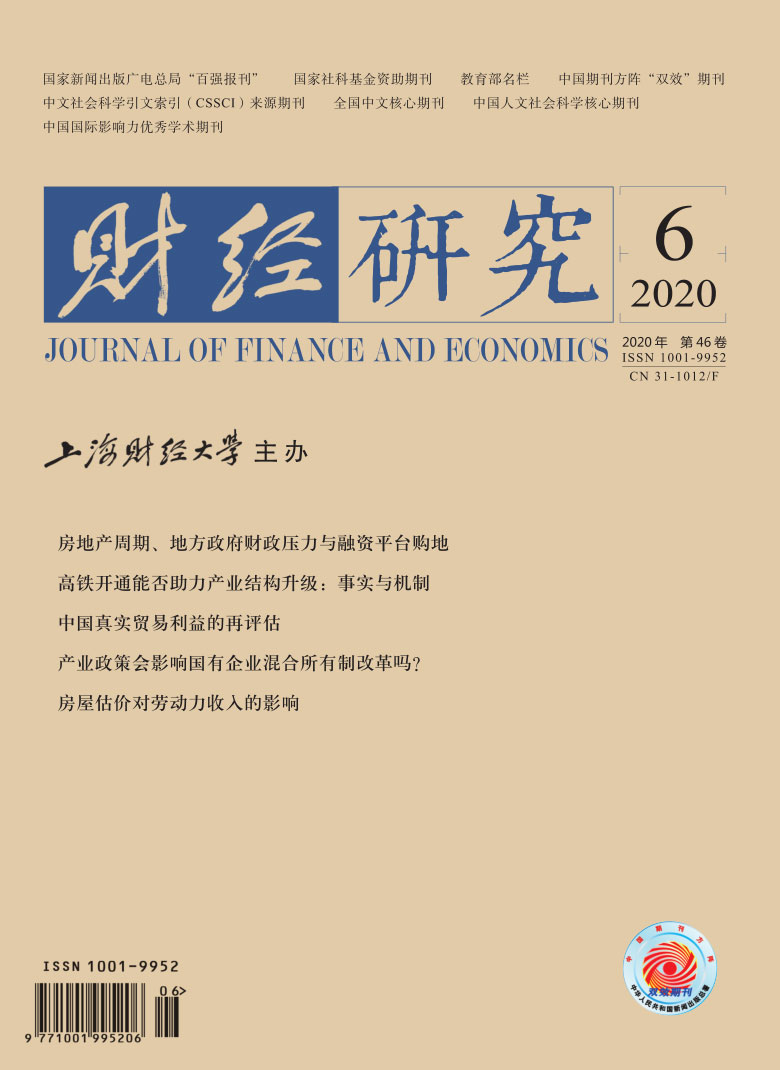[1] Dong X Q, Zhao J, Yuan P W. Reaearch on innovation efficiency loss of state-owned enterprises[J]. China Industrial Economics, 2014, (2): 97-108. (In Chinese)
[2] Li K W, Jiang W, Song L G. The mystery of changes in quality of China’s exports: A micro-level explanation based on market entry[J]. Social Sciences in China, 2014, (3): 80-103. (In Chinese)
[3] Luo H, Chen L L. Study on the impact of VAT transformation reform on financing constrains[J]. Accounting Research, 2012, (12): 43-49. (In Chinese)
[4] Nie H H, Fang M Y, Li T. The impact of VAT transformation on firms’ behavior and performance[J]. Management World, 2009, (5): 17-24. (In Chinese)
[5] Shen G J, Chen B K, Yang R D. Can tax-reduction boost economy in China?——An empirical study based on China’s value-added tax reform[J]. Economic Research Journal, 2016, (11): 70-82. (In Chinese)
[6] Shi B Z, Shao W B. The measurement and determinants of the product quality of China’s exporting firms: The micro-perspective of cultivating new export competition advantage[J]. Management World, 2014, (9): 90-106. (In Chinese)
[7] Su D N, Sheng B, Shao C D. Industrial agglomeration and firms’ export product quality upgrading[J]. China Industrial Economics, 2018, (11): 117-135. (In Chinese)
[8] Su L M, Peng D D, Lan Y S. How does trade liberalization affect the quality of China’s export goods? A perspective of a decline in trade policy uncertainty[J]. Journal of Finance and Economics, 2016, (4): 61-70. (In Chinese)
[9] Tian S, Zhang B W, Mu X R. Fluctuation of foreign exchange rate, intermediate goods, and business export[J]. Forum of World Economics & Politics, 2015, (4): 88-102. (In Chinese)
[10] Wang Y Q, Zhang W K, Hong S J. Export quality and intermediate inputs[J]. Management World, 2018, (8): 30-40. (In Chinese)
[11] Wang Y J, Feng X. The reform of administration approval system and firms’ innovation[J]. China Industrial Economics, 2018, (2): 24-42. (In Chinese)
[12] Xie S X, Liu P D, Wang X S. Price competition, strategic trade policy adjustment and firms’ export mode choicing[J]. Economic Research Journal, 2018, (10): 127-141. (In Chinese)
[13] Xu H L, Wang H C. The effect of minimum wage standards on firms’ export quality[J]. The Journal of World Economy, 2016, (7): 73-96. (In Chinese)
[14] Xu J Y, Mao Q L, Hu A G. Intermediate input imports and the quality upgrading of export product: Evidence from Chinese manufacturing enterprises[J]. The Journal of World Economy, 2017, (3): 52-75. (In Chinese)
[15] Xu W, Chen B K. Tax incentives and corporate investment: Evidence from a quasi-natural experiment of China’s value-added tax reform[J]. Management World, 2016, (5): 9-17. (In Chinese)
[16] Yu M J, Zhang R. How does export quality respond to home currency appreciation: Micro-level evidence from China[J]. Management World, 2017a, (5): 28-40. (In Chinese)
[17] Yu M J, Zhang R. Estimating China’s manufacturing export quality: Pitfalls and remedy[J]. China Economic Quarterly, 2017b, (2): 463-484. (In Chinese)
[18] Zhang J. Financial depression, financing constraints and the quality of China’s export products[J]. Journal of Financial Research, 2015, (6): 64-79. (In Chinese)
[19] Ackerberg D A, Caves K, Frazer G. Identification properties of recent production function estimators[J]. Econometrica, 2015, 83(6): 2411-2451.
[20] Amiti M, Khandelwal A K. Import competition and quality upgrading[J]. Review of Economics and Statistics, 2013, 95(2): 476-490.
[21] Baldwin R E, Harrigan J. Zeros, quality, and space:Trade theory and trade evidence[J]. American Economic Journal:Mi croeconomics, 2011, 3(2): 60-88.
[22] Bas M, Strauss-Kahn V. Input-trade liberalization, export prices and quality upgrading[J]. Journal of International Eco nomics, 2015, 95(2): 250-262.
[23] Brandt L, Van Biesebroeck J, Wang L H, et al. WTO accession and performance of Chinese manufacturing firms[J]. American Economic Review, 2017, 107(9): 2784-2820.
[24] Brandt L, Van Biesebroeck J, Zhang Y F. Creative accounting or creative destruction? Firm-level productivity growth in Chinese manufacturing[J]. Journal of Development Economics, 2012, 97(2): 339-351.
[25] Cai H B, Liu Q. Competition and corporate tax avoidance:Evidence from Chinese industrial firms[J]. The Economic Journal, 2009, 119(537): 764-795.
[26] Capaldo A. Network structure and innovation:The leveraging of a dual network as a distinctive relational capability[J]. Strategic Management Journal, 2007, 28(6): 585-608.
[27] Ethier W J. National and international returns to scale in the modern theory of international trade[J]. American Economic Review, 1982, 72(3): 389-405.
[28] Fan H C, Li Y A, Yeaple S R. Trade liberalization, quality, and export prices[J]. Review of Economics and Statistics, 2015, 97(5): 1033-1051.
[29] Feenstra R C, Romalis J. International prices and endogenous quality[J]. The Quarterly Journal of Economics, 2014, 129(2): 477-527.
[30] Feng L, Li Z Y, Swenson D L. The connection between imported intermediate inputs and exports: Evidence fromChinese firms[J]. Journal of International Economics, 2016, 101: 86-101.
[31] Hagedoorn J, Cloodt M. Measuring innovative performance:Is there an advantage in using multiple indicators?[J]. Research Policy, 2003, 32(8): 1365-1379.
[32] Johnson R C. Trade and prices with heterogeneous firms[J]. Journal of International Economics, 2012, 86(1): 43-56.
[33] Khandelwal A K, Schott P K, Wei S J. Trade liberalization and embedded institutional reform:Evidence from Chinese exporters[J]. American Economic Review, 2013, 103(6): 2169-2195.
[34] Kugler M, Verhoogen E. Prices, plant size, and product quality[J]. Review of Economics Studies, 2012, 79(1) :307-339.
[35] Liu Q, Lu Y. Firm investment and exporting:Evidence from China’s value-added tax reform[J]. Journal of International Economics, 2015, 97(2): 392-403.
[36] Manova K, Yu Z H. Multi-product firms and product quality[J]. Journal of International Economics, 2017, 109:116-137.
[37] Verhoogen E. Trade, quality upgrading, and wage inequality in the Mexican manufacturing sector[J]. The Quarterly Journal of Economics, 2008, 123(2): 489-530.
[38] Wang D. The impact of the 2009 value added tax reform on enterprise investment and employment-Empirical analysis based on Chinese tax survey data[R]. UNU-MERIT Working Papers 059, 2013.
[39] Yu M J. Processing trade, tariff reductions and firm productivity: Evidence from Chinese firms[J]. The Economic Journal, 2015, 125(585): 943-988.
[40] Zhang L, Chen Y Y, He Z Y. The effect of investment tax incentives: Evidence from China’s value-added tax reform[J]. International Tax and Public Finance, 2018, 25(4): 913-945.






 5892
5892  4336
4336

